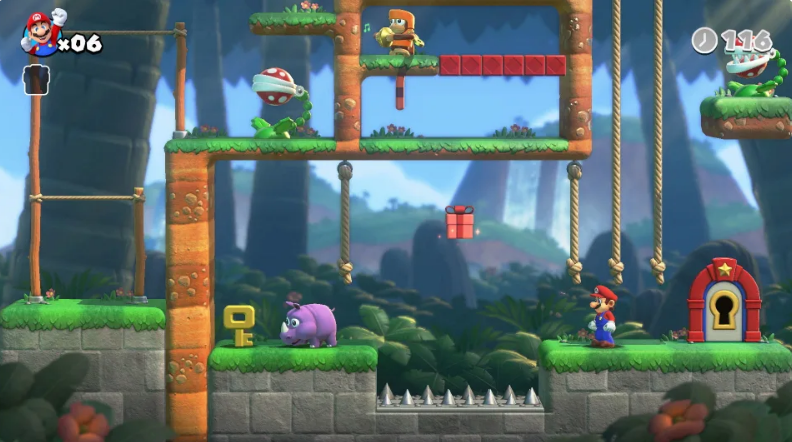It’s no Super Mario Bros. Wonder, but there’s still plenty of fun to be had here.

I never played the original Mario vs. Donkey Kong, which came out in 2004 for the Game Boy Advance. So I brought no nostalgia or past experience to the new version coming out this week, which feels thoroughly modern in all ways except the gameplay. Mario is limited — he can’t run quickly, he doesn’t jump very high, you lose a life with a single mistake. Coming from the brand-new Super Mario Bros. Wonder can give you serious whiplash, as there’s no Elephant power or Wonder Stars to be found here. But if you don’t compare Mario vs. Donkey Kong to the plumber’s more modern adventures, it has some charm all of its own to enjoy.
Mario vs. Donkey Kong has a lot more in common with the original Donkey Kong arcade games than your typical Mario platformer. Each level has two parts, but they aren’t expansive side-scrolling adventures. Instead, it’s a puzzle that requires specific steps and clever usage of the enemies and tools littered throughout. First, you need to get a key, and then you need to rescue a cute little Mario toy that Donkey Kong stole and placed in the level. Sometimes, you’ll need to throw a Shy Guy onto a pit of spikes and ride him across the hazard; other times you’re activating switches in a specific order to get platforms to appear where you need them to advance. As with a lot of the best Mario games, nearly every level introduces a new mechanic, enemy or tool that impedes or helps you finish. These levels stretch both horizontally and vertically, but they’re small, self-contained little worlds.

As usual, Nintendo’s polish is on display here. There are plenty of bouncy orchestral music selections; Mario, DK and all the baddies who pop up throughout are lovingly rendered and controls are tight and precise. That is, once you get used to Mario’s limitations. I didn’t have an issue with Mario being a bit less capable, as it’s a totally different style of game, but I definitely forgot that Mario didn’t have the hops to make it across some chasms.
There’s a surprising amount of content in this game, too. There are eight worlds, two of which are brand-new for the 2024 reissue. Each has six stages, plus a bonus stage and a boss battle. And once you beat the main campaign, there’s a remixed “Plus” version of all those levels available that use the same items and overall characteristics as the original but with a new, more challenging goal — you need to lead a vulnerable mini Mario toy to the exit, and those toys are even less capable than big Mario. It’s a good way to mix up the formula that had gotten extremely familiar by the time I completed the first 64 stages.

As usual, Nintendo’s polish is on display here. There are plenty of bouncy orchestral music selections; Mario, DK and all the baddies who pop up throughout are lovingly rendered and controls are tight and precise. That is, once you get used to Mario’s limitations. I didn’t have an issue with Mario being a bit less capable, as it’s a totally different style of game, but I definitely forgot that Mario didn’t have the hops to make it across some chasms.
There’s a surprising amount of content in this game, too. There are eight worlds, two of which are brand-new for the 2024 reissue. Each has six stages, plus a bonus stage and a boss battle. And once you beat the main campaign, there’s a remixed “Plus” version of all those levels available that use the same items and overall characteristics as the original but with a new, more challenging goal — you need to lead a vulnerable mini Mario toy to the exit, and those toys are even less capable than big Mario. It’s a good way to mix up the formula that had gotten extremely familiar by the time I completed the first 64 stages.

Given the simplicity of this game, it’s fair to say that its target audience might be younger or less experienced than I am. Nintendo included some features to make the game even more accessible, too. There’s a “casual” mode where you can take six hits before you lose a life in a stage, instead of just one. That also removes the time limit, which didn’t stress me out in earlier levels but definitely posed a challenge as the game went on. If you do like trying to beat the clock, there’s a “time attack” mode where you try and beat a target time in the level. And regardless of which play style you choose, you can always just hit “retry” to start a stage over without losing a life. Finally, Nintendo also included local co-op multiplayer, something experienced and novice players may enjoy.
At first, I felt like Mario vs. Donkey Kong was going to be too slight of a game to recommend people spend $50 on. It started off cute and clever, but very simple and with seemingly little depth. But Nintendo surprised me — while it’s definitely a throwback sort of game, there’s a solid mix of challenge and depth here. And as with many Nintendo games, this one should be fun for players of any age. Just don’t expect Mario to have the moves and tricks he does in Super Mario Wonder.
 iTechBahrain Information Technology Digital Marketing Web & Mobile Development Services
iTechBahrain Information Technology Digital Marketing Web & Mobile Development Services